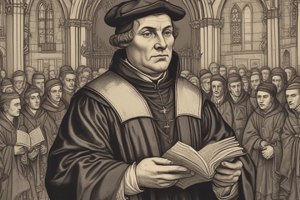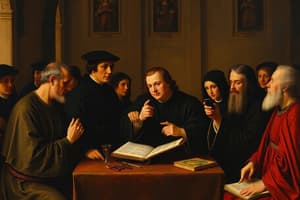Podcast
Questions and Answers
What was a major reason for the Church's financial abuses during the period leading to the Reformation?
What was a major reason for the Church's financial abuses during the period leading to the Reformation?
- Nepotism plagued church offices. (correct)
- Indulgences were only sold to the poor.
- Priests charged high fees for weddings.
- Clerks were exempt from paying taxes.
Who authorized the selling of indulgences to repay a loan to the Fugger family?
Who authorized the selling of indulgences to repay a loan to the Fugger family?
- Albert of Hohenzollern (correct)
- Martin Luther
- Pope Leo X
- Johann Tetzel
What was the primary action that marked the beginning of the Reformation?
What was the primary action that marked the beginning of the Reformation?
- The publication of Luther's treatises.
- Abuses addressed at the Augsburg Diet.
- Luther's excommunication by the Pope.
- The posting of the 95 Theses. (correct)
What principle did Martin Luther advocate for regarding salvation?
What principle did Martin Luther advocate for regarding salvation?
Which group opposed Martin Luther and remained loyal to the Catholic Church?
Which group opposed Martin Luther and remained loyal to the Catholic Church?
What was one of the outcomes of the Fifth Lateran Council held between 1512 and 1517?
What was one of the outcomes of the Fifth Lateran Council held between 1512 and 1517?
What did Martin Luther do as a sign of protest against Pope Leo X's actions?
What did Martin Luther do as a sign of protest against Pope Leo X's actions?
What was the role of Johann Tetzel during the time leading up to the Reformation?
What was the role of Johann Tetzel during the time leading up to the Reformation?
Flashcards
What were Indulgences?
What were Indulgences?
The sale of indulgences was a major practice of the Catholic Church in the 15th and 16th centuries. Indulgences were certificates issued by the Church that granted forgiveness of sins, reducing time in purgatory. They were sold for money, often to wealthy individuals who sought to secure their place in heaven. The practice of selling indulgences became increasingly controversial during this period, leading to the Protestant Reformation.
What was the Reformation?
What was the Reformation?
The Reformation was a major religious movement that began in the 16th century and resulted in the division of Western Christianity into Protestantism and Catholicism. It was sparked by the teachings of Martin Luther, a German monk who criticized the Catholic Church's practices, particularly the sale of indulgences. Luther argued that salvation could only be achieved through faith in Jesus Christ, not through good works or the purchase of indulgences. The Reformation led to a period of significant religious upheaval and social change in Europe.
Who was Martin Luther?
Who was Martin Luther?
Martin Luther, a German monk, was the key figure in the Protestant Reformation. He challenged the authority of the Catholic Church and its teachings, particularly the sale of indulgences. Luther believed that salvation was achieved through faith alone, not through good works or the purchase of indulgences. His teachings were widely embraced by many people, leading to the formation of new Protestant denominations.
What was the Catholic Reformation?
What was the Catholic Reformation?
Signup and view all the flashcards
What was the Augsburg Confession?
What was the Augsburg Confession?
Signup and view all the flashcards
What was the Council of Trent?
What was the Council of Trent?
Signup and view all the flashcards
What was the Fifth Lateran Council?
What was the Fifth Lateran Council?
Signup and view all the flashcards
Study Notes
The Two Reformations
- Pope Leo X authorized the selling of indulgences to raise funds.
- Johann Tetzel, a Dominican friar, traveled selling indulgences.
- Martin Luther, a German monk, protested the sale of indulgences and other Church practices.
- Luther's Ninety-Five Theses challenged the Church's authority.
- Luther's ideas spread rapidly, leading to the Protestant Reformation.
- The Protestant Reformation resulted in the creation of new Christian denominations.
- The Catholic Church responded with the Counter-Reformation.
- Key figures involved included Martin Luther, Johann Tetzel, and Pope Leo X.
- The Reformation period also witnessed conflicts and wars.
Key Figures
- Martin Luther: A German monk who initiated the Protestant Reformation. He critiqued indulgences and other Church practices.
- Johann Tetzel: A Dominican friar who actively sold indulgences.
- Pope Leo X: The pope who authorized the sale of indulgences.
- Albert of Hohenzollern: An archbishop who received income from the church, and secured a loan to pay the pope.
Key Events
- 1517: Martin Luther posted his Ninety-Five Theses, sparking the Reformation.
- 1515-1517: Fifth Lateran Council urged changes to the Church.
- 1518-1520: Luther published several treatises arguing for religious reform.
- 1520: Luther was excommunicated by Pope Leo X.
- 1521: The Diet of Worms happened.
- 1521: Luther was condemned but protected by Frederick the Wise.
Studying That Suits You
Use AI to generate personalized quizzes and flashcards to suit your learning preferences.




